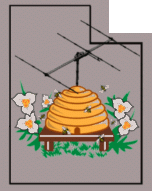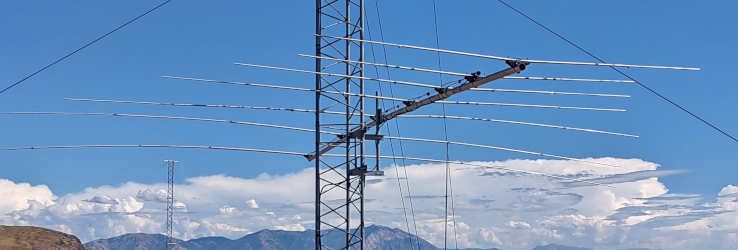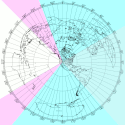 |
| Utah SDR WX |
|
Help support this WebSDR via PayPal - or check, cash, etc. if you don't wish to use PayPal. Find out how!
|
The
Northern Utah WebSDR now has a YouTube channel - see it here! |
30-10 Meters - Northwest-pointing beam
U.S. West Coast, Alaska, Asia, Australia, New Zealand, Pacific
|
This WebSDR is located near Corinne, Utah, about 80 miles (94km) north of Salt Lake City and about 14 miles (23km) east of the Golden Spike National Historic Site.
The Northern Utah WebSDR system has coverage on all U.S. amateur HF, MF and LF bands, 2 meters, the bottom 1 MHz of 6 meters, and several shortwave broadcast bands - see the Technical Info page for more details.
This WebSDR (#5) uses a KLM 10-30-7LPA log-periodic antenna that is oriented to a bearing of northwest - approximately 278° (true) at a height of 53 feet (16 meters) above ground - for coverage of the north and western portions of the U.S. (including Alaska) and Canada. For DX it covers Australia and much of Asia. This antenna provides continuous coverage from 10 through 30 MHz. This antenna was kindly donated by the Ted Elliot Hartson trust.
Maps courtesy NS6T's web site. Just like the beam on WebSDR #4, this antenna is NOT rotatable.
Please note:
There is an occasional issue with power line noise. We believe that we have identifed the hardware involved and are working with the power company to get it resolved.
The 2021/2022 User Survey has finished and you may see the results here.
|
To invoke this page with a preset frequency and mode, append "/?tune=(freq
kHz)(mode)" to the URL and save it as a bookmark as in: http://[WebSDR's URL]?tune=7200lsb
Additional URL parameters are described on the "FAQ" page here.
If you find that CatSync doesn't work with this WebSDR, add "?10hz" to the URL. There may be other issues with CatSync - read here. Remember: If you don't do something (e.g. retune, adjust bandwidth, volume) this WebSDR will time out after 120 minutes. If it does time out, refresh the browser.
Does the echo of your transmitted audio from the WebSDR drive you crazy? This circuit may help! 
Ever wonder where some of those loud static crashes are coming from? A look at the blitzortung.org U.S.A. lightning map may help answer the question! Other WebSDR systems:
|
Western U.S.: KFS, Half-Moon Bay, CA
Eastern U.S.: K3FEF, Milford, PA, NA5B near Washington DC, N4BBQ, Dalhonega, GA
|
More
information about the WebSDR project, including a list of WebSDRs worldwide, can be found at http://www.websdr.org.
|
As per FCC Report and order 25-60 link released 9 December, 2025, becoming effective 30 days after being published in the Federal Register - there are changes to the "60 meter" band as follows:
It seems you are using a mobile device; click here to switch to the mobile version of this site.
It seems Java is not installed or disabled on your computer. You need to install and/or enable it for this website to work properly.
Since Java version 7u51, Java needs to be enabled separately for each website; see http://websdr.org/java.html for instructions.
Your browser does not seem to support HTML5 WebAudio; please try a recent version of Firefox, Chrome, Opera or Safari; or switch to Java.



Bandwidth: ?: ? kHz @ -6dB; ? kHz @ -60dB. Default BW in bold. CW uses a center frequency of 750 Hz and LSB by default. PassBand Tuning (PBT): Logbook: Time, frequency, your name/call, and DXCC information are added automatically. View the last 20 lines of the logbook, or the entire logbook (opens new tab/window). ![[scale]](smeter1.png)
S-meter squelch: Volume: Mute Squelch Notch1 Notch2 High Boost DSP Noise Reduction: Audio buffering: More buffering may help with drop-outs or slow/jittery connections. Vari-Notch (Hz): Off CW Peak (Hz): Off Ref. Tone Gain control: RF AGC Alt AGC Manual
Gain:
devpk
dev_avg
dev_pkavg
Audio channel:
Left
Both
Right
Sig. strength plot:
Waterfall view:
There were 84 users on the Northern Utah WebSDR system (WebSDRs 1-5) as of Sat Dec 20 11:27:01 PM MST 2025.
Statistics:
|


